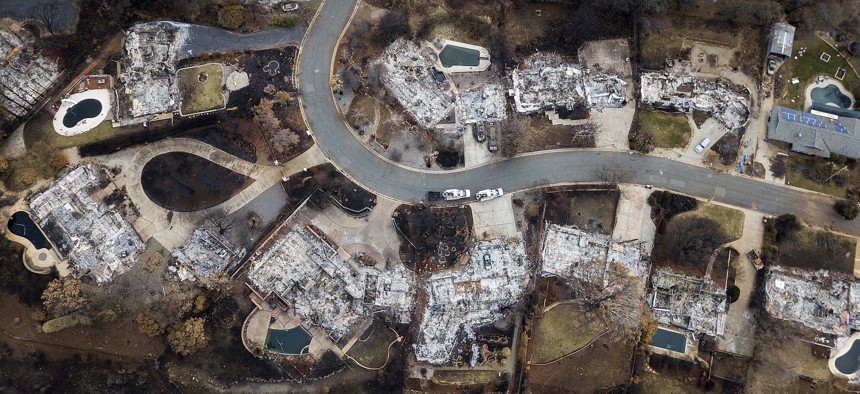A Tough Question in California: Whether to Rebuild in Places That Will Burn Again

Homes leveled by the Camp Fire line Valley Ridge Drive in Paradise, Calif. Noah Berger / AP Photo
Despite the clear and present dangers of the wildland-urban interface, many vow to rebuild in risky spots.
As the community of Paradise, California looks to recover from the state’s deadliest and most destructive wildfire on record, some are questioning whether the Northern California foothills community in Butte County should be rebuilt in such a vulnerable spot.
History, topography and a changing climate are not on the side for those who intend or want to rebuild in hard-to-evacuate Paradise, which is particularly at risk since there are only a few roads leading out of town. That’s something that proved deadly on Nov. 8 when the Camp Fire consumed the woodsy community, which sits squarely within what’s known as the wildland-urban interface, where residential development is built in areas with fire-prone vegetation.
According to the Bay Area News Group, since 1999 there have been 13 large fires in the 153,000-acre footprint of the Camp Fire, which killed at least 88 people and destroyed more than 14,000 structures last month. And looking back to records dating back to 1914, there have been 38 fires of at least 300 acres within the Camp Fire’s burn scar.
“The interface is really susceptible to very large losses because there tends to be a big cluster of houses,” RMS disaster analyst Chris Folkman told the Bay Area News Group. “At the same time, it’s an extremely desirable place to live … it’s picturesque.”
Despite a vast majority of their community destroyed, some Paradise residents have vowed to rebuild while others aren’t planning to return.
In Southern California, the Woolsey Fire, which recently burned through parts of northwestern Los Angeles County last month is likely the most destructive in Malibu’s history. Residential losses estimated at $1.6 billion, according to an analysis of aerial imagery and property records by the Los Angeles Times and real estate data company Zillow.
November’s monster blazes in California have prompted many to take another look at “The Case for Letting Malibu Burn,” a provocative chapter in the 1998 book, Ecology of Fear by Mike Davis.
As Quartz featured last month:
Davis wrote that the Santa Monica mountains’ native vegetation interacts with perfect fire weather—“drought conditions, 100-degree heat, 3 percent humidity and an 85-mile-per-hour Santa Ana wind”—to create fires, on average, every two and half years. And he argued that the longer Malibu sought to suppress fires in order to save ever-increasing amounts of property, the worse its inevitable fires would be. “Science has established that it is accumulated growth that determines fire destructiveness,” he wrote. “Botanists and fire geographers have calculated that half-century-old chaparral, heavily laden with dead mass, burns with 50 times more intensity than 20-year-old chaparral.”
According to The New York Times, more Americans are living in areas considered to be in the wildland-urban interface—12.7 million more house and 25 million more people than in 1990.
PREVIOUSLY on Route Fifty:
Michael Grass is Executive Editor of Route Fifty and is based in Seattle.
NEXT STORY: Americans Are Moving Less Than Ever






